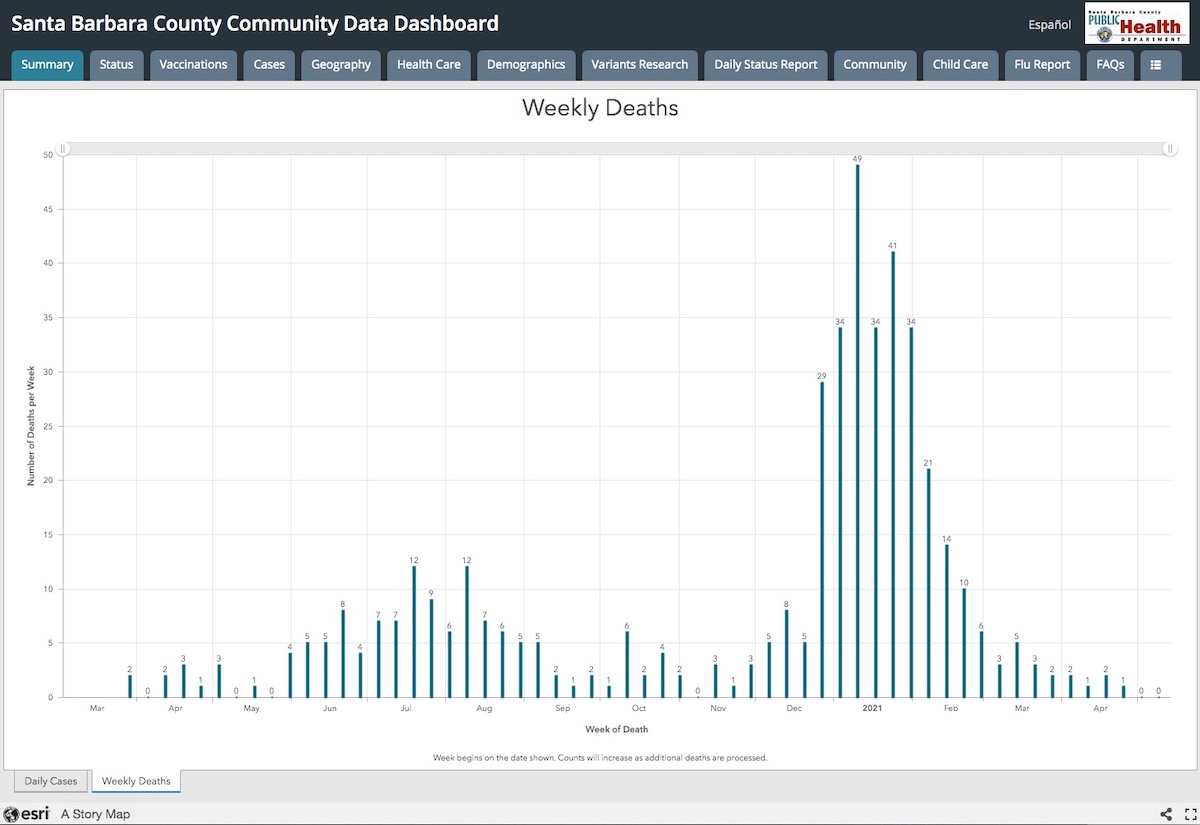Pandemic Procreation Down, Deaths Up
Santa Barbara County Kept Pace with the Rest of the Country

Mercifully, Santa Barbara County’s COVID death count has been zero for the month of May, and even in California, which leads the nation in coronavirus deaths, the daily number of deaths has been dropping — from 600-plus in January to fewer than 70 in May. As we knock on wood that this trend continues, the flip side is that while Santa Barbara County had babies, it just didn’t have as many as before.
In terms of life expectancy in the U.S., which has hardly budged this past decade and ranged between 78.54 and 78.84, it dropped a full year for 2020 to 77.8, according to the Centers for Disease Control (CDC). COVID was an underlying or contributing cause to 11.3 percent of the deaths, said the CDC. The agency normally takes 11 months to compile death statistics, but it put a provisional set together as of October 2020 because of the near real-time information collected during the pandemic.
Equally, the number of deaths nationwide varied by about one percent from year to year during the past decade. In the first half of 2020, however, that increased to 15.8 percent over the previous year. COVID moved into third place behind heart disease and cancer in deaths that year.
“The real number of deaths from COVID may be closer to a million nationwide than about 600,000 — many deaths have not been attributed to COVID that should have been,” said Lanny Ebenstein, an economist and lecturer at UC Santa Barbara who has studied demographics extensively. “National deaths are usually a very stable number,” he explained; normally, they vary with the population’s age, which changes slowly.
Santa Barbara County’s winter surge of COVID cases bears out the larger number of deaths. In January 2021, coronavirus killed 192 people. That January registered the highest number of deaths — 476 — in one month in the county over the past seven years. The only other month since 2014 with more than 400 deaths was December 2020, according to the California Death Report. It wasn’t until late February that Santa Barbara’s weekly death count dropped below 10.
Deaths During Peak COVID Surge
| Dec 2020 | Jan 2021 | Feb 2021 | |
| Total Monthly Deaths | 411 | 476 | 349 |
| Total Monthly COVID Deaths | 47 | 192 | 51 |
| Previous year’s month for comparison | 261 | 310 | 298 |
Santa Barbara’s spring in 2021 is drastically different from last spring. A year ago, we knew nothing about COVID. Testing was new and took two to 10 days for results to be returned, infections at Lompoc prison quietly led to inmate deaths, confusion grew over wearing masks and how to make them, vaccines were nonexistent, and students began to suffer depression from being deprived of contact with their classmates and friends. The disruption subsided and became the new normal, and the intervening year resulted in a birth-rate decline.
“We have pretty much averaged 25 to 30 births a month for years,” said Nora Wallace, spokesperson for Lompoc Valley Medical Center. But November 2020 dipped to 17 and February 2021 dipped to 13, indicating some hesitation on procreation in the valley. Births at Marian Regional Medical Center in Santa Maria saw a 4 percent drop from January through April 2021 compared to the same months the previous year. The CDC reported a similar 4 percent drop in births nationwide overall the previous year.
Cottage Hospital was an outlier, however, delivering more babies this year than last. Its birthing suites had 2.5 percent more deliveries in the first four months of 2021 — 655 infants — compared to 639 in the first quarter of 2020.
Ebenstein noted that birthrates have declined across the nation for 15 years and never recovered from a greater dip that began after the Great Recession. The same is true for Santa Barbara County, and the 5,589 births in 2019 dropped by 2.7 percent to 5,437 in 2020.

Births and deaths also have a political impact. The 2020 Census recorded the population nationally as growing overall but at a slower rate than in past decades. For seven states, California among them, their population growth was so small, compared to some other states, that it cost them each one congressional seat. Texas gained two, and five other states each gained one.
The Census looks at changes over 10 years, however, and how much the pandemic will affect the collective population remains to be seen. Media skeptics can recall the early assumptions made about New York City’s great blackout of 1965. The resulting conclusion that an abundance of babies arrived nine months later just wasn’t true. J. Richard Udry of the University of North Carolina debunked that myth, but curious researchers took up the study of birthrates after hurricanes, tropical storms, and tsunamis. They often came to the same conclusion that the New York Times had, erroneously, in 1966, but with the data to back them up.
The pandemic emergency has been arguably different from a natural disaster, however. The lights stayed on, meeting new people was off the menu, and government was engaged enough to declare pharmacies — and their aisles of birth control options — essential businesses. Additionally, there’s probably nothing like a deadly airborne pathogen to kill any whiff of romance in the air.
Support the Santa Barbara Independent through a long-term or a single contribution.



You must be logged in to post a comment.